Over the past 30 years, we’ve seen an uptick in the number of large wildfires. In the Western US, wildfire season has increased to 7 months of the year. (1)
Climate change means more snowmelt and rains during spring, which in turn causes lots of vegetation growth. When this vegetation dries out in the hot summer, it fuels MASSIVE wildfires.
It isn’t just California that is affected. Projections show that every ecosystem is going to see an increase in wildfires. (4)
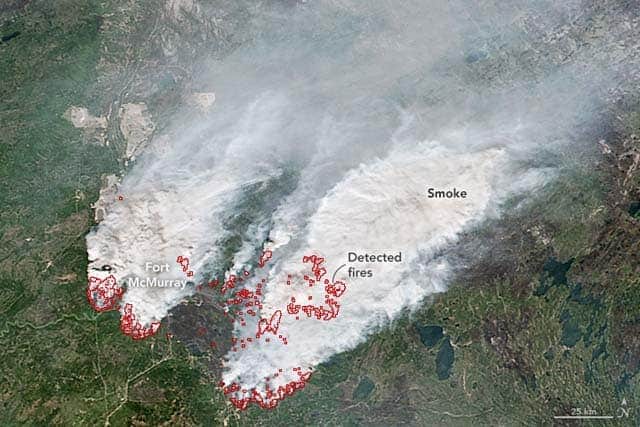
At FEMA, Ready.gov and Wunderground, you can find some advice for preparing for a wildfire. However, I find this advice severely inadequate. Sure, you should make a “sign up for alerts” and “clear an area around your home.” But the reality is that wildfire preparedness is a lot more intensive than their guides make it sound.
Jump To:
- Wildfire Risk Denial
- Before a Wildfire Hits
- Steps to Fireproof Your Home
- When There’s a Wildfire Threat
- If Trapped in Your Home
Denial: No One Wants to Believe They’ll Be Hit by a Wildfire
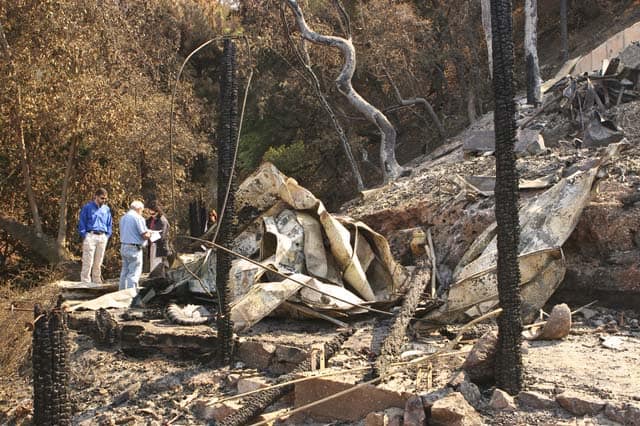
The first step in preparing for a wildfire is to take the risk seriously. Unfortunately, whether it is for a wildfire, hurricane, earthquake, or massive power outage, we humans are generally terrible at planning for natural disasters.
We see this every time a natural disaster hits.
People refuse to evacuate their homes. They don’t have necessary supplies like food and water stockpiled. They let their emotions cloud their judgment. Many end up dying unnecessarily.
As this article points out,
“Generally, people don’t respect the power of potential disasters, and they don’t adequately plan for them.”
There are two main reasons for this. One is the “perfectionist fallacy”: That since it is impossible to plan for a disaster perfectly, you might as well not do anything. Of course, this is ridiculous when you think about it rationally – any amount of preparation is better than nothing!
The other fallacy is simply wishful thinking. But wishful thinking will not spare you from a natural disaster.
So, while it might seem tedious or “unnecessary” to go through all of these wildfire preparation steps, ensure you follow through. You don’t want to beat yourself up afterward because your wishful thinking made you unprepared.
Before a Wildfire Hits
These are all steps you should take NOW. When a wildfire warning is in effect, you won’t have time to do any of them.
1. Sign Up for Alerts
Don’t rely on news or TV to keep you informed. Instead, make sure you get alerted to wildfire threats immediately by:
- Signing up for text or email alert systems. Just do an internet search for Your town, city, or county and the word alerts. Example: Here is how California residents can sign up for alerts.
- Get an NOAA emergency radio with alerts. Here are some of the best emergency radios.
Don’t forget to consider how you will stay informed if the power goes out. Have spare batteries, a solar or crank charger, and choose an emergency radio that can run on alternative power (such as a crank).
2. Stockpile Emergency Supplies at Home
Even if your region isn’t directly affected by the wildfire, you might lose power. Tap water (if still available) might not be safe to drink. For these reasons, you must be prepared to shelter in place.
At the very minimum, it is recommended that you have a 3-day supply of food and water. However, a 30-day supply is much smarter (for these reasons).
To get started, read:
- Guide to emergency water
- Survival foods list
- How to make an emergency toilet
- Complete first aid kit checklist
3. Get Insurance in Order
One common fallacy that people have is, “I have insurance, so I don’t have to worry about disaster planning.”
But many natural disaster survivors will tell you how terrible the insurance process is.
Many discover that they were grossly underinsured. You may be required to do a home inventory of everything in your home. When your entire home has been burnt down, that’s very tricky – not to mention emotional!
To prepare:
- Update your insurance policy. Be aware that many insurers are no longer willing to give wildfire insurance in high-risk areas (about half of California). If you cannot renew or get a policy, read this fact sheet.
- Get flood insurance. Deforestation from wildfires means an increased risk of flooding and mudslides. Make sure your insurance policy covers this, too.
- Do a home inventory. Here’s a guide on how to do an inventory for insurance purposes.
- Make digital copies in the cloud: Your home inventory and any important receipts should be in digital format. Keep these stored in the cloud so they can’t be lost during a wildfire.
4. Be Prepared to Lose EVERYTHING
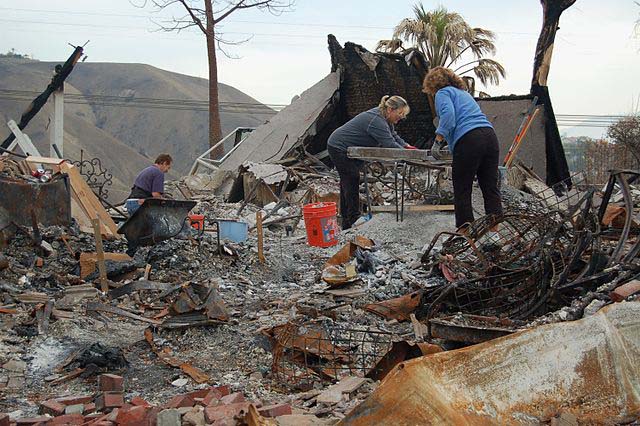
This is where wishful thinking gets in the way of wildfire survival. As Tony Stoltzfus recounts the moments before the Carr Fire forced him to evacuate,
“You look at the sky and you can’t see anything. You think: ‘Well, the firefighters are really good.’ You think: ‘I’m not going to take that because it will be disruptive to put it all back when we return.”
That thinking led him to take his computers, documents, and other items with monetary value, but nothing was irreplaceable or held sentimental value.
Now, he regrets not taking his family photos, journals, and handmade furniture – like the dining room table he used instead of an engagement ring to propose to his wife.
They might just be “things,” – but things have value. As PS Mag points out in their article about items lost in wildfires,
“Sentiment appears over and over in conversations about lost belongings. ‘Things are things,’ evacuees say, or ‘Everything can be replaced,’ or ‘It’s just a house, plaster and wood.’ Perhaps they say these phrases aloud so often because they are trying to convince themselves.”
How can you prepare to lose everything?
- Make digital copies and put them in the cloud: Do this for photographs, letters, and other paper items.
- Take photos of cherished belongings: Take pictures of the embroidered tablecloth your grandmother made or mementos from travels. Store these photos in the cloud. You probably won’t take these items when evacuating, so they could be lost in a fire – but at least you’ll still have the pictures.
- Consider your young children: I know my daughter would be CRUSHED if she lost certain stuffed animals she’s had since she was a baby. Make a note of these items so you can grab them quickly when evacuating.
- Keep important valuables packed and ready: When practical, keep valuables (including those with sentimental value) packed together to make them easy to grab and go.
Remember, you may have less than 20 minutes to evacuate – and there might not be power or light. You won’t have time to sort through boxes of baby mementos, jewelry, quilts, and other items. Everything must be ready to go! Be prepared to lose anything which you did not pack ahead of time.
5. Pack a Go Bag
Wildfires can travel as fast as 10-20 miles per hour. (5) If one is nearby, you must be ready to leave immediately.
You should have a go-bag packed with all the necessities needed to survive. It could be weeks before you can return to your home. You might not have a home to return to.
Pack:
- Essential personal items: Such as clothing for 3-5 days, hygiene items, towels, baby wipes (great for when you can’t take a shower), and extra glasses or contact lenses/solution
- Baby care items: Like formula, extra bottled water, bottles, diapers, wipes, and a baby carrier. More on prepping with children.
- Communication devices: Your cell phone, chargers, laptop, emergency radio, and contacts list.
- Medications: Including allergy medications, inhalers, prescription meds, and copies of your prescriptions
- Papers and documents: Passports, IDs, credit cards, and birth certificates. See what to put in your emergency binder. You should also take the step of putting these in digital format and storing them in the cloud. (Binder template here)
- Pets and their items: Keep pet carriers near the door and ready. Have food, bowls, leashes, and other items packed. Remember that you will probably need proof of vaccinations for your pet to be accepted into a shelter. Read this article about evacuating with pets.
- Comfort items: Bringing a book or deck of cards is a good idea. It will relieve some mental stress while you pass the time in your emergency shelter.
- Emergency supplies: Some non-perishable foods, water, flashlights, a first aid kit, and a map of the area.
- Fire-specific items: Including an N95 mask, portable fire extinguisher, and fire blanket
- Valuables: As discussed above, have your most precious sentimental or valuable items packed and ready to go.
6. Make a Communication Plan
How would you contact family members if you had to evacuate while someone wasn’t at home? You can’t rely on cell phones during emergencies, especially since coverage can go out and lines can be flooded.
For this reason, it is vital to make an emergency communication plan. The plan should include a meeting point and a way to get in touch.
Read how to make an emergency communication plan here.
7. Make Evacuation Plan
Many people die during wildfires because they fail to evacuate on time. You may only have minutes to evacuate, and your emotions will be running high. These emotions can cloud your judgment, so you need to have a plan in place before you have to evacuate.
Plan:
- Your escape route: You need at least two routes in different directions. Get a map and look at alternate roads if one is inaccessible due to the wildfire.
- A vehicle: Keep your car tank at least half full with gas. Gas stations will not be open during a wildfire. If you don’t have your vehicle, then talk to your neighbors about evacuating with them. You’ll need to coordinate with multiple neighbors in case one isn’t home.
- Where will you go? Talk to friends and relatives about whether you can visit their homes during an evacuation. They should live sufficiently far away from you to escape the danger zone. Choose people in multiple directions so you have options.
WRITE YOUR PLAN DOWN.
In an actual emergency, priorities become muddled. You might forget things that seem obvious – like to grab your Go Bag or take your pets. Write everything down as a checklist to follow during evacuation.
8. Run a Drill with Your Family
Drills are a form of “emergency conditioning.” They help you mentally familiarize yourself with the disaster. If the catastrophe does occur, you will be more likely to react appropriately instead of freezing or making mistakes.
Make sure you practice your wildfire evacuation plan with your family as a drill. You’ll also need to practice using the fire extinguisher in the drill.
Steps to Fireproof Your Home
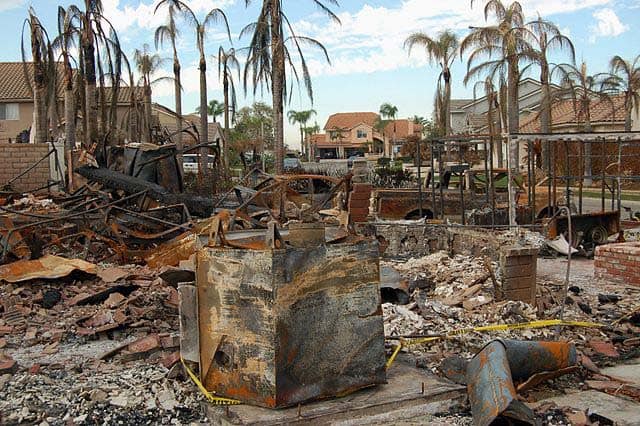
One of the things that amazes me about wildfires is that their destruction seems arbitrary. Take a look at the image above – one home is completely razed to the ground. The neighbors’ homes are unscathed.
Some homes stand amid a sea of ash; the reason mainly concerns the wind’s direction (wind sends sparks shooting in certain directions) and whether firefighters could make a stand.
You can do things to prevent your home from going up in a blaze – even if the houses around you are burning.
FireWise Action Plan
I suggest you check out the FireWise USA program to learn how to fireproof your home. They have many resources for reducing the risk to your family and community.
What’s particularly great about FireWise is its state liaison program. The state forestry/fire agency appoints liaisons. They will perform assessments of your community and help your community make an action plan. Find your FireWise State Liaison here.
Overview of Fireproofing Steps
I won’t pretend that I’m an expert in fireproofing homes. There is a LOT that goes into fireproofing. Some things are simple – like keeping your yard free of flammable debris and furniture. Other steps are more complicated, like knowing which landscaping to use. That’s why you should contact the FireWise program.
Expect to take these steps:
In/On Your Home
- Cover chimney and stove outlets with a small mesh screen. This will prevent embers from getting into your home.
- Use non-combustible or fire-resistant materials for your roof and the exterior of your home (including decks and trim).
- Treat combustible materials with fire-retardant chemicals that an accredited laboratory recognizes.
- Regularly clean gutters and roofs
30-Feet Around Your Home
- Keep this area free of leaves, pine needles, dried branches, and other flammable debris
- Have a sprinkler in an accessible location. It should be able to reach all areas of your property.
- Select landscaping plants that contain fires instead of fueling them.
- Store any flammable materials, such as gasoline, in safety cans away from your home
200-Feet Around Your Home
Ideally, an area of 200 feet around your home should be fireproof. This might extend to your neighbors’ yards, so getting your entire community involved in wildfire preparedness is so important.
What to Do When There’s a Wildfire Threat
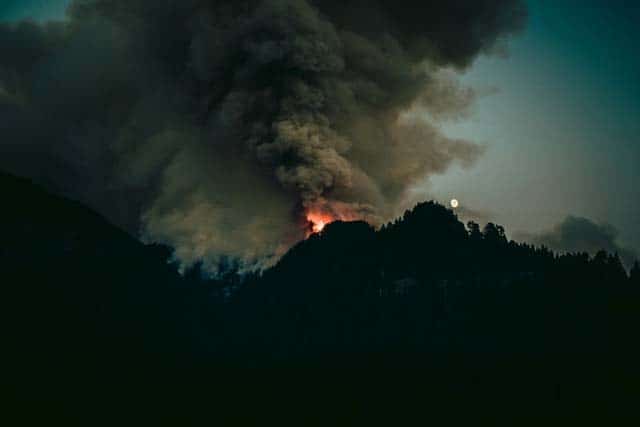
Remember that even the most levelheaded people can get emotional during disasters. That’s why making an evacuation plan before a wildfire hits is essential. WRITE DOWN YOUR PLAN so you follow the proper steps and don’t forget anything important!
Here is what you need to do if there is a wildfire threat nearby or you can see a wildfire coming.
Wildfire Warnings
Just like with other natural disasters, wildfires have different levels of warnings. Understanding them is crucial.
- Fire Weather Watch: A Watch alert means the conditions could result in a wildfire within 12-48 hours. However, no wildfire has occurred yet during a Watch. Avoid BBQs, cigarettes, and anything else that could cause a wildfire.
- Red Flag Warning: A fire is occurring or will likely happen within the next 24 hours. Take extreme caution with any flames or sparks.
- Extreme Fire Behavior: This alert means that a wildfire is occurring and could rage out of control. When this alert is issued, you should be ready to evacuate if necessary.
If a Wildfire Is Nearby
Your priority should be evacuating. Things can be replaced. Lives cannot. However, if you have time, you can follow these steps before evacuating:
- Keep pets inside. You don’t want to be searching for them when it is time to evacuate!
- Wear smart clothing. This is not the time to be walking around in flip-flops. You need clothing suitable for evacuation.
- Get your car ready. It should be packed and facing out of the driveway so you can quickly drive away.
- Turn off propane or natural gas.
- Turn on all lights. This will help firefighters see better.
- Put a ladder to the roof on the front of your home. This will also assist firefighters.
- Close all windows, doors, and fire screens (prevents drafts, which will cause the fire to spread faster)
- Cover vents, windows, and other openings with pre-cut pieces of plywood
- Remove flammable curtains and drapes from windows.
- Put sprinklers on the roof. Turn them on.
- Use a hose to fill any pools, hot tubs, or large containers with water.
- Disconnect automatic garage door openers so they can be opened by hand if necessary. Close the garage door.
- Move flammable furniture to the center of your home, away from windows and sliding doors.
- Place valuables that water won’t destroy in your filled pool, hot tub, or pond.
- Do not put livestock or animals in barns/pens/coops. If these structures catch fire, they will not be able to escape. It is safer to let them roam in pastures. You can also take animal evacuation steps, like writing your name/number on animals with a livestock crayon.
When Evacuating a Wildfire
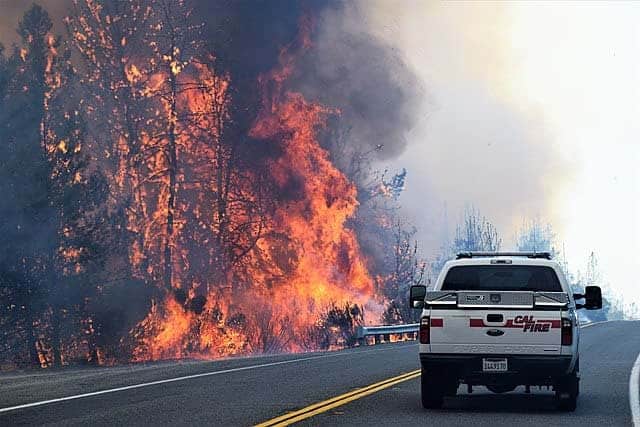
If you’ve prepared in advance, you should be able to escape danger quickly.
While evacuating, you must wear your N95 face mask to keep particles out of your lungs. Have your emergency radio turned on so you know which routes are safest.
Important: Preparing your home for evacuation is a lot of work. It is also very emotional. But don’t succumb to “evacuation fatigue.”
This is the term that authorities use for people who’ve had to evacuate their homes multiple times. They worry that repeated evacuations might make people reluctant to leave again.
Remember that emotions and wishful thinking cause people to DIE during natural disasters. It is better to evacuate early than put firefighters at risk when they come to rescue you. And it is undoubtedly better to evacuate “unnecessarily” than have your family plan your funeral.
If Trapped in Your Home During a Wildfire
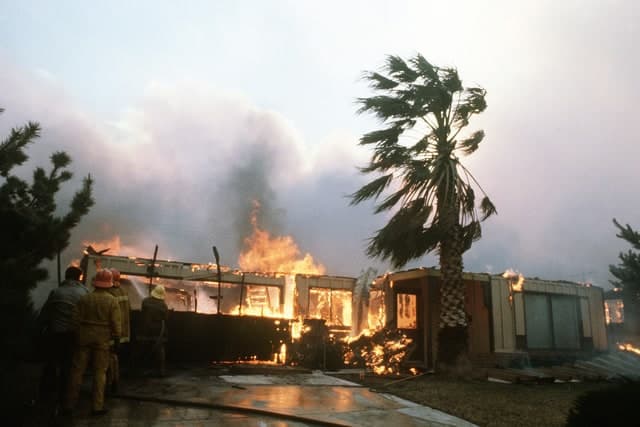
We don’t hear many stories of people who survived being trapped in their homes during a wildfire. The sad truth is that people who don’t evacuate on time are likely to die in the flames. However, there are rare miracle stories.
Almost everyone who survived a wildfire did so by jumping into a pool or pond.
Daniel and Cindy Pomplun were sleeping when evacuation orders were issued (which emphasizes why you need an emergency radio with alerts). By the time they realized they had needed to leave, it was too late.
The couple stayed in their home for as long as possible. When their garage caught fire and smoke filled the house, they ran into their pool. They remained in the water, watching their home burn to the ground, with wet towels wrapped around their heads. They had to submerge into the water entirely and only come up for air during the worst. Once the house was wholly consumed, the fire moved on.
John and Jan Pascoe have a similar story of survival. They dashed their neighbor’s pool and stayed there for 6 hours, asking themselves, “How long does it take for a house to burn down?”
When the Camp Fire hit a community that was unable to evacuate in time, over a dozen people survived by jumping into a frigid lake.
Not everyone survived by jumping into the water, though. A pediatrician and others trapped survived by fighting the approaching fire with garden hoses.
What can we learn from this? If you are trapped in your home during a wildfire:
- Call 911 and provide your location. But don’t count on being rescued. Take steps to save yourself.
- Fill all tubs and sinks with water.
- Stay in your home for as long as possible. Keep away from outside walls and windows. Remove any flammable items from windows.
- Keep doors, windows, and vents shut.
- Run into a filled pool, hot tub, or pond. Wrap wet towels around you to protect against the heat while in the water.
- If you are trapped in your car, park in an area clear of vegetation. Roll up your windows and close vents. Lie face down and cover your body with a wool blanket if you have one. Do not use synthetics as these will melt and burn you.
If you prepare ahead of time and evacuate when there’s a threat, then hopefully, you will never be trapped by a wildfire. Don’t let wishful thinking get in the way – start making a wildfire preparation plan now!
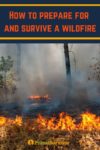


One should be aware of where rivers, streams, bodies of water are located.
IF one can not outrun a wildfire (in the wilds)…find a body of water…scoop out the dirt by the shoreline and make a well to hide in. This will protect the body from burns. The smoke may be a problem and one can push sand back to form a door. Water carries oxygen. If you splash the water it produces oxygen. (Same if a ship or car sinks.) Think of using a non combustible roofing tile and stone siding. Would tarp staple ontop of roofing serve to slow down the fire? Example, Fort McMurry. Parents with children tried to outrun the fire. Thing is, there was a river flowing along side of the highway and they were only less than a mile from the river. As the fire took over, the vehicles were ordered to go across the river on top of ?planks and rocks? to the other side of the river where there was no fire. KNOW YOUR SURROUNDINGS. The fire was stopped by loggers paid by an Ontario woman to log out an area butted against a crossing road….remove as many trees as possible and burn the fire back towards the fire. It stopped…poof it was out. But, what about the people running in front of the fire…some were rescued. don’t run in front…look at the wind…go sideways.
Fantastic info Iris. Thanks for sharing, this could save somebody’s life.